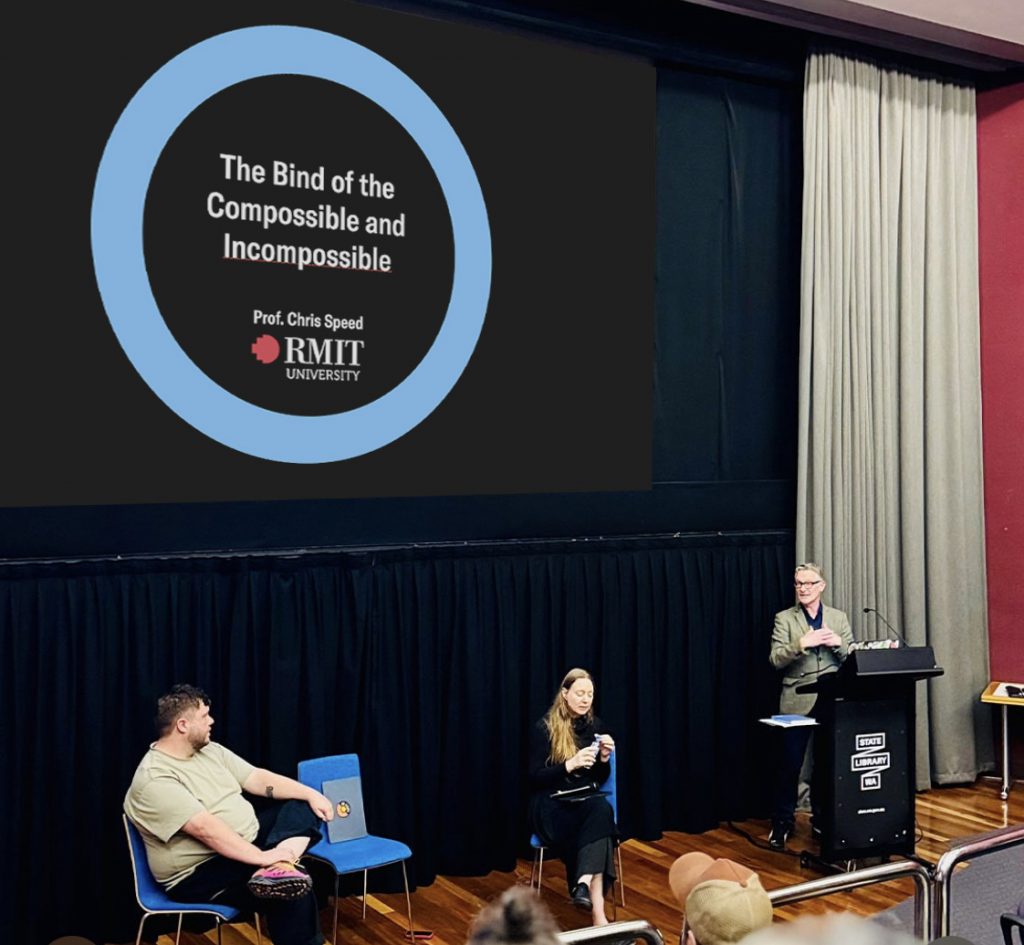The Impact of the Network Society upon a Social Temporal Consciousness
Back in June, Larissa Pschetz and I presented a short paper at the Slow Technology workshop at DIS2012. Organised by William Odom, Carnegie Mellon; Richard Banks, Microsoft Research; Abigail Durrant, Culture Lab / Newcastle University; David Kirk Culture Lab / Newcastle University; and J ames Pierce, Carnegie Mellon University, the workshop recovered Hallnäs and Redström’s 2001 paper Slow Technology. The paper argued that the increasing availability of technology in environments outside of the workplace requires interaction design practice to be expanded from creating tools to make people’s lives more efficient to “creating technology that surrounds us and therefore is part of our activities for long periods of time” ( p. 161).
The core goal of the workshop was to critically reflect on the work that has emerged since Slow Technology was originally proposed, in order to forge understanding of the challenges, limitations and opportunities characterizing the contemporary design space.
Larissa and I responded to the invitation by submitting the following short position. The paper is available here, but we thought that it would be a smart idea to include the trailers of the movies to offer a richer text…
The Impact of the Network Society upon a Social Temporal Consciousness
Chris Speed & Larissa Pschetz
ABSTRACT
In this paper the authors reflect upon the past thirty years since the emergence and public awareness of what Castells describes as the network society [1] with the shifts in a social temporal consciousness that are evidenced through popular cinema. The short paper contextualizes slow technology within larger societal concerns for time, before introducing four epoch’s within recent cinema that give insight into the condition of a social temporal consciousness.
Author Keywords
Temporality, time, network society, temporal consciousness
SLOW TECHNOLOGY IS…
The concept of Slow Technology reflects an uncertainty in the speed and direction in current aspects of society and culture. The need to ‘slow down’ is a response to an uncomfortable circumstance that warrants an action. At present there are a series of global circumstances that are causing people to want to slow down in order to reassess a number of conditions that are beyond their comprehension such as: global warming, the collapse of financial systems, and even doubt in spiritual frameworks. The authors use a series of popular movies to evidence the shifts in cultural consumption away from reliable and traditional temporal frameworks, towards non-linear and unstable models of time. In brief the authors Slow Technology artefact is a collection of movies that from the last 30 years.
TEMPORAL CONSCIOUSNESS
The authors adopt the term ‘temporal consciousness’ from Adam and Thrift [2, 3] who use it to describe the trend of understanding time by a particular group in a specific historical era. The researchers reflect upon the state of this ‘public temporal consciousness’ as we enter the second decade of the second millennium. In the last twenty years, as the network society has grown to include a third of all people in the world, a series of events have placed pressure upon the models of time that have dominated Western society. From the millennium that evoked hysteria in the form of the Y2K bug and the catalogue of Hollywood blockbusters that foretold the end of the world, to Harold Camping’s prediction of the ‘Rapture’ in 2011, security in a stable model of time has been replaced with an interest in more flexible notions of time. Whilst teleological ‘grand narratives’ that offer a model of time remain largely intact, the researchers explore a series of cultural indicators that suggest how the internet and networked experiences are beginning to offer different social / temporal consciousness. Given the speed and veracity of Hollywood’s ability to produce depictions of the world using digital technologies, the researchers use a series of case studies taken from cinema since the 1980’s that explore how the temporal models that operate within each ‘environment’ as network culture has evolved.
Keeping the Linear Intact
In the 80s and early 90s a series of movies began to identify the symptoms of a condition of post-modernity [4]. Their narratives creatively played with new notions of time without changing the traditional linear model. In Back to the Future (1985) the main character travels to the past and back to the same point in future, and in Groundhog Day (1993) the character suddenly finds himself stuck in one day but the linear model is maintained. This movement can be compared with early moves from a modern to a postmodern model of flexible accumulation. In the same way, corporations such as Benetton and Toyota, anticipating a network culture, benefitted from a post-Fordist approach to production and consumption [5].
Back to the Future Trailer, Universal Pictures, 1985.
Ground Hog Day Trailer, Columbia Pictures, 1983.
Anxiety for the End of Days
As we approached the year 2000, Hollywood exploited an anxiety that was emerging from the increasing doubts in traditional and Western Christian models of time and a growing uncertainty in the clarity of modern values that were epitomised in subjects such as nuclear fuels, space travel, and the comfort in knowing who enemies were (during the Cold War for example). Films such:
X-Files: Fight the Future, 20th Century Fox, 1998.
Independence Day, 20th Century Fox, 1996.
Deep Impact, Paramount Pictures and DreamWorks SKG, 1998.
Armageddon, Touchstone Pictures, 1998.
The Day After Tomorrow, 20th Century Fox, 2004.
all evoked the same fear for an ‘end of days’ that the Y2K bug played upon in order to sell more insurance.
Recovering Control of Time
In a subsequent trend within cinematic narratives, technology affords a capacity to overcome dominant temporal structures through subversive acts, collaborative practices and in particular the hero/heroine adopting a role that is anti-establishment. Many of films within this bracket also infer a vocabulary that is associated with network processes: mobilisation of crowds, distributed systems, programming and the role of code.
From films such as:
The Truman Show, Paramount, 1998.
The Matrix, Warner Bros, 1999
In Time, 20th Century Fox, 2011
The stories present a temporal hegemony that is used to control subjects, and plots unfold that adopt methods of hacking to contest these systems.
Inception, Warner Bros, 2010.
Source Code, Summit Entertainment, 2011.
The Adjustment Bureau, Universal Pictures, 2011.
The films dealt specifically with teleological systems and adopt radical techniques that the protagonists embody in order to subvert or challenge a ‘world’.

An image of ‘the paths’ that the protagonists are on according to The Adjustment Bureau, Universal Pictures, 2011.
Network Time
More recent movies, directly reflect an influence of the network society, they reinforce the idea that technology is part of our lives, that it can provide alternative notions of time and space and that it is instrumental in producing new futures, one that is fragmented and highly contingent. Technology thus promises the unexpected, which is at the same time fascinating and frightening.
Life in a Day, National Geographic Films, 2011, is perhaps the most literal example of capitalising upon the ‘crowd’ who contribute to the content of a film that documented multiple experiences from the 24th of July 2010.
Inception, Warner Bros, 2010.
The Time Travellers Wife, New Line Cinema, 2009.
Inception and The Time Travellers Wife both relax any need to adhere to a teleological structure and the audience is required to adopt a very different temporal ‘consciousness’.
SUMMARY
In summary, the authors are aware of the many cultural artefacts including literature, theatre, fine art, cinema and television that have for many years asked questions about temporal systems. However, the purpose of this short position paper is to highlight the scale of consumption of a particular form of media in which temporal structures are manipulated. All of the movies cited are considered popular and successful, with examples such as The Day After Tomorrow grossing $544,272,402, Inception $825,532,764 and The Adjustment Bureau $127,869,379. From this brief analysis of themes across the last 30 years the authors hope to have provided insight into what may be described as a ‘turn’ in the temporal consciousness of society. Although the research stands as conjecture, the authors feel that this position paper introduces a link between the occasions of the millennium, the condition of post modernity but crucially the introduction and growth of the network society with shifts in public models of time. Returning the theme of the workshop, an interest in Slow Technology may be understood to be a further characteristic of a society that has began to put less faith in the grand narratives that made promises about a secure future. Critically aware of the technological determinism that has dominated much of the twentieth century both by selling new products but also solving problems, Slow Technology firmly situates design within a social, economic and environmental context and refuses to be seduced by the old Microsoft slogan “Where do you want to go today?”.
REFERENCES
1. Castells, M. Rise of The Network Society. Oxford: Blackwell Publishing (1996).
2. Adam, B. Timewatch: The Social Analysis of Time. Cambridge: Polity Press (1995).
3. Thrift, N. Spatial Formations. London: Sage (1996).
4. Harvey, D. The Condition of Postmodernity. Cambridge: Blackwell (1990).
5. Belussi, Fiorenza: Benetton Italy: beyond Fordism and flexible specialisation. The evolution of the network firm model. In: Swasti Mitter (ed.): Computer-aided Manufacturing and Women’s Employment. The Clothing Industry in Four EC Countries, Berlin, 73-91 (1992).
Related posts

“This communication is not for you.”
Looking to connect 2 recent events / conversations (as is my want) this time to explore a fundamenta

Design Frequencies: Sharing International Practice in Design Research
Already deep into semester two here. Last semester School of Design RMIT College of Design and Socia

The Labour of the Rejected / “Walk the Plank”
Still playing catchup with so many events. A few weeks ago during hashtag#DIS2025, Mafalda Gamboa an

Design Contradictions
Two projects during Melbourne Design Week with collaborators Michael Dunbar and Liam Fennessy to exp

Paradox of Collaborative Speed
Two events in Melbourne over the past 10 days week revealed a tension across contemporary technology

Slow Materials, Slow Money: Can Design Decelerate?
Two events that I’m trying to tie together to glean some connections. The CHI panel on Regenerativ

From Food Networks to AI Governance
Back to reporting on events in Narme/Melbourne. From Food Networks to AI Governance: Reflections on

Planetary Pedagogies
Following the launch of PlanetaryCivics two weeks ago, this is the second extension to contributions

Space Debris to House Keys
Part 2 of catching up with the weeks of activity in Melbourne through February. From Space Debris to

Measuring our demise
Oh Melbourne, three parallel events that spanned the week: RMIT College of Design and Social Context